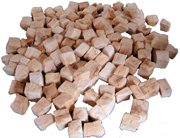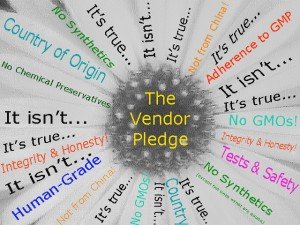31st Dec 2011
Best Wishes for the New Year!
We wish all of you the Best for the New Year!
Let’s put smiles on those faces that ask so little, but make us happy……
 Posted by Heidi Junger, PhD under
Posted by Heidi Junger, PhD under  Organic Pet Food Standards
Organic Pet Food Standards  Comments Off
Comments Off
 |
31st Dec 2011
We wish all of you the Best for the New Year!
Let’s put smiles on those faces that ask so little, but make us happy……
 Posted by Heidi Junger, PhD under
Posted by Heidi Junger, PhD under  Organic Pet Food Standards
Organic Pet Food Standards  Comments Off
Comments Off
31st Oct 2011
No, our products don’t “meet or exceed AAFCO standards.”
Let me explain. We don’t believe that a mineral/vitamin mix, which—depending on the supplier—isn’t shelf stable for more than 3 or 6 months,* can ever substitute for real, whole food-based nutrients.
Most of the supplements used in typical mineral/vitamin premixes are synthetic, isolated, and/or genetically engineered. Although some regard them as ‘insurance for health,’ such isolated nutrients can never undo the damage done by poor food choices. Just consider how sick today’s pet populations are despite the fact that most receive ‘balanced’ or ‘complete’ foods that meet or exceed AAFCO-recommended nutrient levels. There are increasing numbers of disease epidemics in pets. At the same time, pets don’t seem to live longer, healthier lives.
Although it would be easy—certainly profitable, and perhaps even cost-effective—to include a premix of vitamins and minerals among our food ingredients to achieve AAFCO ‘required’ nutrient levels for ‘whole or balanced meals,’ this isn’t what we’re about, here at Onesta Organics.
We recommend supplementing your pet’s whole food diet which could certainly include our products, with high quality supplements. This way, you can be sure of the quality and effectiveness of the nutrients in both the food ingredients and nutritional supplements your pet receives.
———-
* Shelf life starts from the manufacture of the premix and not the time the product is added to the pet food.
 Posted by Heidi Junger, PhD under
Posted by Heidi Junger, PhD under  General - Pet Food, Onesta Organics Pet Foods
General - Pet Food, Onesta Organics Pet Foods  Comments Off
Comments Off
11th Oct 2011
Watch this short video about the ‘natural’ claim scam in the cereal business. The same ‘natural’ scam is going on in the pet food industry. Don’t forget that only certified organic pet food claims are regulated and enforced.
 Posted by Heidi Junger, PhD under
Posted by Heidi Junger, PhD under  Organic Pet Food Standards, Regulations
Organic Pet Food Standards, Regulations  Comments Off
Comments Off
23rd Sep 2011
 Many dog and cat beds are commercially available. But, quite a few that we’ve looked at are too bulky to wash on a regular enough basis to keep them sanitary and healthy, and some are simply too bulky to throw into the washer in the first place. Others are made from materials we don’t consider healthy, including synthetic or nanoparticle-containing so-called ‘dirt- or liquid-repellent’ materials. Moreover, many beds that are made from healthy organic materials are also too bulky to keep clean.
Many dog and cat beds are commercially available. But, quite a few that we’ve looked at are too bulky to wash on a regular enough basis to keep them sanitary and healthy, and some are simply too bulky to throw into the washer in the first place. Others are made from materials we don’t consider healthy, including synthetic or nanoparticle-containing so-called ‘dirt- or liquid-repellent’ materials. Moreover, many beds that are made from healthy organic materials are also too bulky to keep clean.
We’ve found a simple solution (we like to call it the “econodog” or “econocat” bed) that is not only easily washed, versatile, and comfortable, but also economical: quite simply, a good quality pillow or seat cushion made from natural materials that’s covered with a pillow case.
You can easily wash all components. If the pillow case is too large for the pillow, you can easily adjust its size with a few simple stitches, or just fold the excess fabric under the pillow itself. You can repurpose or reuse what you have or buy something new or second-hand (in both cases, make sure you wash the pillow and/or pillow case before letting your pet use it/them). This way you can be sure of the quality and safety of the material your animal sleeps on, keep his or her bed safe and clean, and stay well within your budget. If your pet needs more or less support, you can easily modify the bed to his or her specific requirements. The bed components can be easily adjusted to your pet’s size. And, since its cover can be changed regularly, the bed need never become a boring piece of furniture. So, to sum up: keep it safe by keeping it simple!
 Posted by Heidi Junger, PhD under
Posted by Heidi Junger, PhD under  Home Remedies & News Bits
Home Remedies & News Bits  Comments Off
Comments Off
16th Sep 2011

Now here’s a little tidbit that just came across my ‘radar’: I can buy freeze-dried cat and dog treats, at wholesale prices, that are made from Alaskan salmon and other fish (‘whitefish’ and tuna) via a Seattle-based distributing hub.
Sounds like a great deal for any pet food company that doesn’t want to prepare the food from scratch, right? What’s so interesting about this? Well, these particular fish are prepared in China! Although the processor claims that they use Alaskan wild salmon, there’s no independent party that can verify this. Even with all the cutting of corners I’ve seen in the pet food industry over the past few years, I must admit that I was surprised by this. Earlier, I had assumed - wrongly, of course - that at the very least, all wild Alaskan salmon treats are processed in the US. Undoubtedly, many consumers - and even some retailers, including veterinarians!- make the very same assumption. And clearly, there isn’t a reliable source for this kind of information.
By the way, I was approached, in my capacity as a pet food manufacturer, to buy this China-processed salmon for resale. When I inquired further, I was stunned to find out that wild Alaskan salmon is processed for pet treats in China. Aren’t there enough companies in the US that are interested and able to do this, or is such home-grown processing simply not cost-effective? In any case, I would never consider reselling these products, despite their very attractive wholesale price. As I mentioned earlier, there’s no way of knowing whether we are really dealing with wild Alaskan salmon.
The foregoing highlights another potential source of misinformation: just because a pet food website or product package lists a US address, it doesn’t mean that the product originates from, or was manufactured in, the US. So, it’s important to keep in mind that several pet food companies simply repackage products which they purchase from other manufacturers. They then sell these products as their own, packaged in their brand’s box, bag, or tub. With the notable exception of USDA certified organic pet foods, manufacturers aren’t required to declare the actual source of the products they sell. So, be aware: your favorite pet food company may just be repackaging what other companies make for them.
P.S.: At Onesta Organics, we’re proud of the fact that we prepare all our pet food products from scratch in our own facility. It’s not always easy, but it’s always rewarding to know exactly what we are selling to our customers and their pets.
 Posted by Heidi Junger, PhD under
Posted by Heidi Junger, PhD under  General - Pet Food
General - Pet Food  Comments Off
Comments Off
01st Sep 2011
An amazing video of an amazing dog.
 Posted by Heidi Junger, PhD under
Posted by Heidi Junger, PhD under  Home Remedies & News Bits
Home Remedies & News Bits  Comments Off
Comments Off
25th Aug 2011
 Sometimes, dogs, cats, and other pets itch. This can be due to a bite, a bad diet, or a side effect to several popular drugs.
Sometimes, dogs, cats, and other pets itch. This can be due to a bite, a bad diet, or a side effect to several popular drugs.
We saw a severe reaction to a very common heartworm medication. The day after the first (and last) dose of the drug, both dogs who received the medication, started to vomit ‘empty’ which was unusual for them; occasional vomiting continued for several days. The skin of both animals became inflamed and pinker than usual. After a few days, the skin of one of the dogs started to break out so harshly, that the animal bit herself ‘raw’ in one area. A few hours later, she developed red spots on her now red-hot skin which soon turned into blisters. She itched terribly and scratched fiercely. That evening, she was truly miserable.
At this point I started to give her the homeopathic remedy Rhus Toxicodendron (Rhus tox.) which is an effective remedy for many skin ailments. I gave her several rounds in two hours (per mouth), and her skin started to return to normal; the blisters vanished within a few hours. It was obvious that her itch was gone as well, since she stopped scratching herself. The next morning, I gave one more dose although her skin was already almost normally colored with only faint pinker spots where the blisters used to be.

A day later, the skin was normally colored, and the former blister areas were almost invisible. The skin of her brother, who received a few does of Rhus tox. as well, also returned to its normal color. Curiously, both animals also stopped vomiting after they received the remedy.
Thankfully, homeopathic remedies are readily available and I had the right one at home. It is amazing how powerful these remedies are in both humans and pets.
 Posted by Heidi Junger, PhD under
Posted by Heidi Junger, PhD under  Home Remedies & News Bits
Home Remedies & News Bits  Comments Off
Comments Off
23rd Aug 2011
There are many pet insurances available to provide coverage for cats and dogs. Years ago, we insured our pet rats with VPI and found that in their case, the insurance really didn’t pay off. Rats aren’t good candidates for insurance; they are too short-lived and almost every health problem can be classified as either a preexisting or congenital condition. Pet rodents also usually don’t have that many accidental injuries as they can occur with pets that have access to the outdoors.
Although the following video seems to be made by one of the featured pet insurance companies, it highlights how different the coverages through pet insurance companies can be.
 Posted by Heidi Junger, PhD under
Posted by Heidi Junger, PhD under  Home Remedies & News Bits
Home Remedies & News Bits  Comments Off
Comments Off
26th Jul 2011
There is a new marketing gimmick going around. The vendor pledge. Some health food stores state that they collect vendor pledges to assure high standards and integrity of their ingredients and products. And now, even some pet food companies have announced with great flourish (using paid press releases from PR agencies, friendly or associated blogs, their own websites, etc.) that they now require their vendors to supply them with pledges for each ingredient they use. The ingredients need to be GMO-free, cannot be sourced from China, the animals need to be raised and processed in the best possible ways, etc.
This sounds great. So what’s the problem, and why am I writing about it?
The answer is simple: None of these so-called ‘vendor pledges’ can be verified. Many comforting and reassuring words are flying fast and furious, but there’s no independent party that can verify all these great-sounding words. It’s as if a company released favorable results from a poll they conducted themselves. Now, honestly, how much faith would you place in such results?
Why advertise vendor pledges?
That’s an easy one: profit, pure and simple.
What are meaningful alternatives to such pledges?
 The most meaningful alternatives are third party-enforced certificates.
The most meaningful alternatives are third party-enforced certificates.
Two examples are:
1) a USDA organic certificate; and
2) a non-GMO statement that’s also legally binding (they are required for any certified organic pet food that contains non-certified organic ingredients such as citric acid).
An additional alternative is a statement from the Humane Society that declares that a particular poultry farmer/processor is far above industry standards in respect to the humane treatment of animals (I might also mention here that, at Onesta Organics, we use such a farmer’s products routinely). As in the case of the first two examples, this declaration can be verified by a third party.
The nice thing about the USDA organic certificate is that any company (including Onesta Organics) that receives such certification is inspected at least once yearly (food factories for human consumption foods are generally inspected less than once per decade), and all ingredient choices must be shared with a USDA-accredited certification agent. This agent knows where the ingredient comes from, if it is human-grade, free of pesticides, antibiotics, and other synthetics, etc.
In the case of a vendor pledge, all you have to go on is the word of a given company and nothing more. The sad truth is that vendor pledges can’t be verified and aren’t based on any enforced standards. With an enforced certificate, at the very least you have the assurance that any false claims have serious legal consequences.
So, when you’re faced with a choice between a vendor pledge and a certificate from the USDA, a statement from the Humane Society, or any other entity requiring third-party oversight, you now know which one of the two is trustworthy!
 Posted by Heidi Junger, PhD under
Posted by Heidi Junger, PhD under  Organic Pet Food Standards, Regulations
Organic Pet Food Standards, Regulations  Comments Off
Comments Off
12th Jul 2011
This blog title seems too weird to be worth writing about. So why bother?
Because the competition doesn’t sleep. Perhaps they want to make sure they can’t be accused of actually breaking the law. Nevertheless, they may well be violating consumers’ trust. Oh well…why not, if you can make money hand over fist and no one’s the wiser?
For years, a pet food company that I can’t name here has promoted their pet foods (e.g., cat food and dog foods) as ‘raw,’ ‘dehydrated,’ and ‘human grade, among other things. But, they’ve also passed their products off as ‘organic’ even though none of these products have actually been certified as organic. Companies like mine work very hard to meet USDA organic standards, and we pay a heavy premium for our organic ingredients and certification fees to do so-not to mention the additional time we spend to maintain our certification. Anyone who purchases an Onesta Organics product can rest assured that they’re getting truly organic pet foods of the very highest quality. Anyone who purchases from the competitor I mention here can’t be sure what they’re getting; they can’t verify this competitor’s claims, and sadly, they probably don’t know any better.
Recently, this company posted updated information on their website about their raw dog and cat foods. They now admit that their “…fresh raw meats and white fish undergo gentle steaming at 140°F to 165°F.” You’ve gotta love the use of the terms, ‘fresh,’ ‘raw,’ and ‘gentle’ in this sentence - could it be that these words are meant to take the ‘heat’ out of the term, ‘steaming,’ which they also use in the same update?
Steaming at 140°F to 165°F may appear to be ‘gentle’ to many folks. But the reality is that steaming any food achieves the same end result as actually cooking that food, i.e., steamed fish and meat are indeed cooked. And curiously, as the company states in one of their own press releases, the products in question are ‘essentially cooked.‘
The revealing information discussed above isn’t easy to find on this company’s SEO-friendly, but somewhat confusingly organized, website without the use of key words such as ‘gentle,’ ‘steaming,’ ‘fish,’ ‘meat,’ ‘dehydration,’ and ‘pet food’ (as a matter of fact, after reading this, you should go ahead and google these very terms to see what listings come up; it’ll be very educational-I guarantee it!). This company’s site is so chock full of detailed information that one could easily overlook the fact that steamed (read ‘cooked’) ingredients are actually being used in products marketed as ‘raw’ and ‘gently dehydrated.’
No sour grapes here-just an impassioned plea to the consumer to educate themselves…and beware.
It’s sad that dishonesty of a few casts a bad light on all members of an industry.
Anyway. Just another hot topic to share.
 Posted by Heidi Junger, PhD under
Posted by Heidi Junger, PhD under  Raw Pet Food
Raw Pet Food  Comments Off
Comments Off